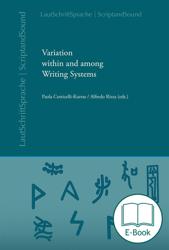The present volume, edited by Paola Cotticelli Kurras and Alfredo Rizza, deals with the variation within the systems of writing focusing on various aspects: the metalanguage of the discipline, the methods of analysis, the history of writing, its adaptation in the different cultural environment, the orthographic and linguistic policies, from Ancient Anatolia, Crete and Greece, and Italy to medieval Europe and Iceland.
The volume opens a newly founded series devoted to historical graphemics. The research field of graphemics is multidisciplinary and represents a bridge between philology, historical linguistics, epigraphy and semiotics. Historical graphemics deals with changes in writing systems and the alternative adaptations, contaminations and responses by individuals or groups within their cognitive and/or cultural framework.
The present volume, edited by Paola Cotticelli Kurras and Alfredo Rizza, deals with the variation within the systems of writing focusing on various aspects: the metalangue of the discipline, the methods of analysis, the history of writing, its adaptation in the different cultural environment, the orthographic and linguistic policies. The geographic and the chronological coordinates range from the historical alphabets of Europe (from the runes to the Old and Middle English or Old and Middle German traditions and the Old Italian texts) to the hieroglyphic and logosyllabic systems of the Mediterranean (Linear A and B) and the Near East (cuneiform and hieroglyphics in ancient Anatolia). The underlying cultural traditions testify the peculiarity of individual scriptures as an expression of local cultures. Good examples are provided can be found in Ancient Anatolia with the two systems attested in the II mill. b.C. in the Hittite realm (cuneiform and hieroglyphs), and, in the I mill. B.C. with the local alphabets and the challenges they pose for the quest of the origin and spreads of alphabets in the Mediterranean area. This volume also hosts the editio princeps of a new Sidetic inscription. Other interesting examples are to be found during the European Middle Ages, in particular aspects of orthographic variants in Old Icelandic and Old Italian. For the Mycenaeans variations in the administrative texts were characteristic and functional to social and cultural aspects of the time.
„[T]he foundation of this LautSchriftSprache – ScriptandSound series is a significant development in promoting interdisciplinary work in historical graphemics, and subsequent volumes in the series will contribute further to progress in this field.“
Von: Anna P. Judson
In: Bryn Mawr Classical Review 2017.08.38
----------------------------------------------------------------
„1e origins of the volume lie in a conference of the same name as the volume series, LautSchri0Sprache (ScriptandSound; Verona 2013), which was the third one in the series. Twenty-one papers out of those presented in the conference have been published in the volume. 1e volume therefore presents an impressive collection of languages [...] However, the true richness of the volume does not lie in the collection of languages and their writing systems discussed, but on the analysis concerning the di!erent structures of writing systems and their "t with the (morpho-)phonological structures of other languages, when borrowed (“the perfect "t”). [...] the volume also includes studies on the chronology of the development of writing systems, studies on writing support, and cultural context, to mention a few. In this way, the volume certainly brings in something novel to the "eld, and is a welcome addition to the more traditional approach to research on writing systems.“
Von Sonja Dahlgren
In: Arctos 54 (2020), S. 391 f.
Paola Cotticelli studied in Pavia (I) and in Munich, where she received her PhD. She is full professor for Historical and Indo-European Linguistics and Head of the Center for Foreign Languages at the University of Verona, scientific and editorial board member and author of “Hethitisches Wörterbuch”. Main research fields: comparative syntax and morphology of Indo-European languages, lexicography, Anatolian languages, Ancient Greek, Ancient Lithuanian, Metalanguage and History of concepts in the History of Linguistics and Grammaticography.
She is also head of the “Laboratorio del lessico di linguistica” (
www.linguisticslab.org) a research center for metalanguage, writing systems (cuneiform, alphabets, hieroglyphs), and researches on brand names. Recent research projects: „Indogermanische Syntax: der Satz, die Syntax der Nebensätze“ (2014-2022); „Die Syntax des Partizips und konkurrierende Konstruktionen“ financed by the Foundation F. von Thyssen (2014-2016); Syntax of Luvian (Marie Curie Horizon 2020, 2015-2017).
Alfredo Rizza is researcher at the University of Verona. Born in Salò he studied in Pavia and Firenzen and received grants for research at the University of Berkeley, Würzburg and Graz. His interests span from ancient Cultures and Civilizations of the Aegeo-Anatolian Area to contemporary theories of language and semiotics. He is junior professor for General and Historical Linguistics at the University of Verona.
Die Reihe LautSchriftSprache ist der historischen Graphematik gewidmet. Als ein multidisziplinäres Forschungsgebiet stellt die Graphematik die Brücke zwischen Philologie, Sprachgeschichte, Epigraphik und Semiotik dar. Daher beschreibt die historische Graphematik die allgemeinen Strukturen überlieferter Schreibsysteme. So beschäftigt sie sich beispielsweise mit Veränderungen im System und der Reaktion darauf durch die einzelnen Sprecher- bzw. Sprachgruppen, d.h. deren individuelle Lösungsmöglichkeiten im Rahmen dieser Strukturen. Die geographischen und die chronologischen Koordinaten reichen von den historischen Alphabeten Europas bis hin zu den chinesischen Logogrammen über die hieroglyphischen und logosyllabischen Schriftsysteme des Mittelmeeres und des Vorderen Orients.


 Table of Contents
Table of Contents